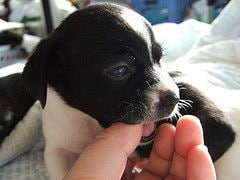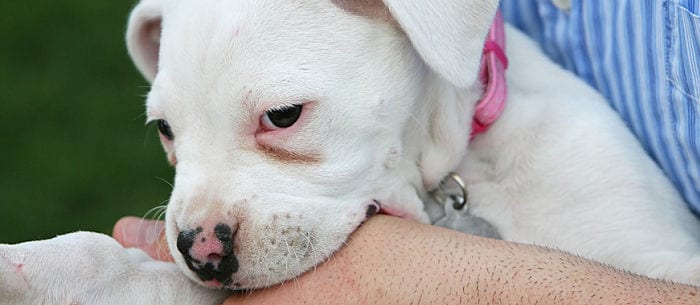Does your puppy love to nibble on your fingers? While she may not do so with aggressive tendencies, this behavior can become destructive. As such, it’s important that you work to manage your puppy’s biting as soon as it begins. Here’s everything you need to know about puppy biting and how to get matters under control!
Why Do Puppies Bite?
Much like babies and toddlers, “puppies use their mouths to explore everything,” says Lydia Yancey, the assistant director of training at DogBoy’s Dog Ranch in Pflugerville, Texas. “They start to use their mouths when they experience frustration, boredom or overexcitement.” According to Yancey, puppy biting is basically a way of throwing a tantrum. If you don’t take steps to get your puppy’s biting under control, it has the potential to become a serious problem.

It’s important for you to teach your dog how to handle his feelings and understand which behaviors are socially acceptable, just as you would do with a child. But your pet’s age makes all the difference! Puppies need at least eight weeks with their brothers and sisters to learn a few things about socialization.
“They learn bite inhibition with their litter,” says Barbara Flick, a certified dog trainer and the owner of Good KarmaDog Center in Omaha, Nebraska. “If they bite too rough, the other puppy will yelp and walk away.”
How Can You Teach Your Puppy to Stop Biting?
Here are six steps you should take to control your puppy’s bad habit:
- Ask Yourself Why Your Puppy Is Biting
Yancey suggests that you start by asking yourself if your puppy is biting as a result of an external factor or need. For instance, she may be acting out this way because she is hungry or has to use the bathroom. It’s also possible that your puppy is biting because she is overexcited or misses you. If one of these factors have come into play, you can address it directly.
- Redirect the Behavior
It’s important for you to teach your puppy what actually is acceptable to bite. You can do so by introducing him to toys and treats.
- Don’t Engage
Your puppy sees all attention as good attention. When you scold her, she may misinterpret it as praise. As such, Yancey recommends that you put your arms up and walk away from your puppy if she won’t calm down or listen to you. And be sure to encourage everyone else in the house to do the same!
- Use a Crate or Create a Puppy-Friendly Area in Your Home
Your furry friend should not be allowed to roam all over your house. Just like toddlers, puppies need proper supervision. As such, Yancey recommends that you use a crate until your puppy is at least two to three years old and out of her adolescent period. The crate should always be a good, happy place where your puppy can go to calm down and self-soothe.
- Play With Your Puppy
Most dogs want to be with people, says Flick. In fact, “a lot of dogs are bred to be companions or work mates.” It’s important that you play with your puppy on a regular basis, because a bored puppy is a mischievous puppy. Try throwing a ball or playing hide and seek. And be sure to walk your dog for at least 30 minutes twice a day to provide exercise and mental stimulation!
- Send Your Puppy Back to School
Yancey suggests that you look for a positive reinforcement trainer to help you teach your dog how to behave properly.
Overall, it’s important to remember that “dogs don’t do these things to be naughty,” says Flick. “They just don’t know any better.”
Bayan Raji is a freelance writer.




